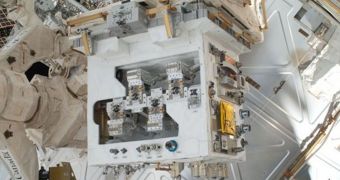Later this summer, the American space agency plans to conduct a highly anticipated Robotic Refueling Mission (RRM) demonstration aboard the International Space Station (ISS). Officials with NASA announce the successful completion of another round of preparatory RRM operations.
The maneuvers involved the use of specific RRM tools and the Canadian-built Dextre robotic arm, which is affixed to the exterior of the orbital lab. According to the agency, gaining the ability to refuel spacecraft in space will be essential for future planetary exploration missions.
The refueling technology is currently being developed by a joint team at NASA and the Canadian Space Agency (CSA), and comes in the shape of an ISS experiment attached to the outer walls of the lab. Its purpose is to repair and refuel satellites in low-Earth orbit (LEO).
The primary targets of the RRM experiment are satellites that were not built with servicing in mind. Most of these spacecraft were designed to spend a few years in LEO, and then burn in the atmosphere.
The Hubble Space Telescope, for example, was developed so that it could be captured by American space shuttles, and repaired in orbit. One of the reasons it has managed to remain in operation for 22 years is that five such repair missions have been conducted over the years.
Now, NASA and CSA want to extend the lives of other missions as well, which were not designed with this capability in mind from the get-go. The RRM will provide a wealth of data on the challenges associated with performing such operations.
“Now that these tasks are complete, our eyes are now set on the RRM refueling demonstration and the eventual benefits that it will bring to the aerospace industry,” official Benjamin Reed explains.
“Every year, functional satellites providing weather, communications, and other essential services are retired because they have reached the end of their fuel supply,” adds the scientist, who is the deputy project manager of the Satellite Servicing Capabilities Office (SSCO).
“We envision a future where refueling services extend the lifespan of these satellites and increase capacity for users and consumers. RRM is designed to prove this robotic refueling technology, and we are looking forward to practicing this task in late summer 2012,” he goes on to say.
The SSCO is currently based at the NASA Goddard Space Flight Center (GSFC), in Greenbelt, Maryland.

 14 DAY TRIAL //
14 DAY TRIAL //